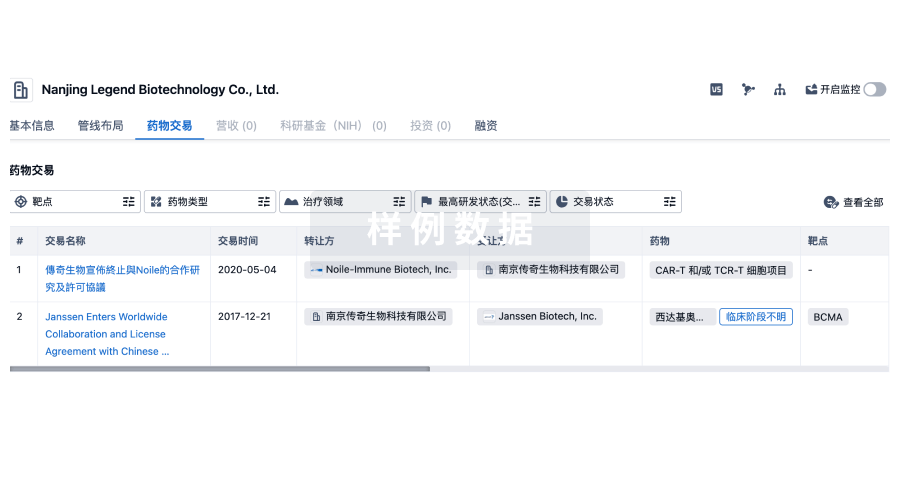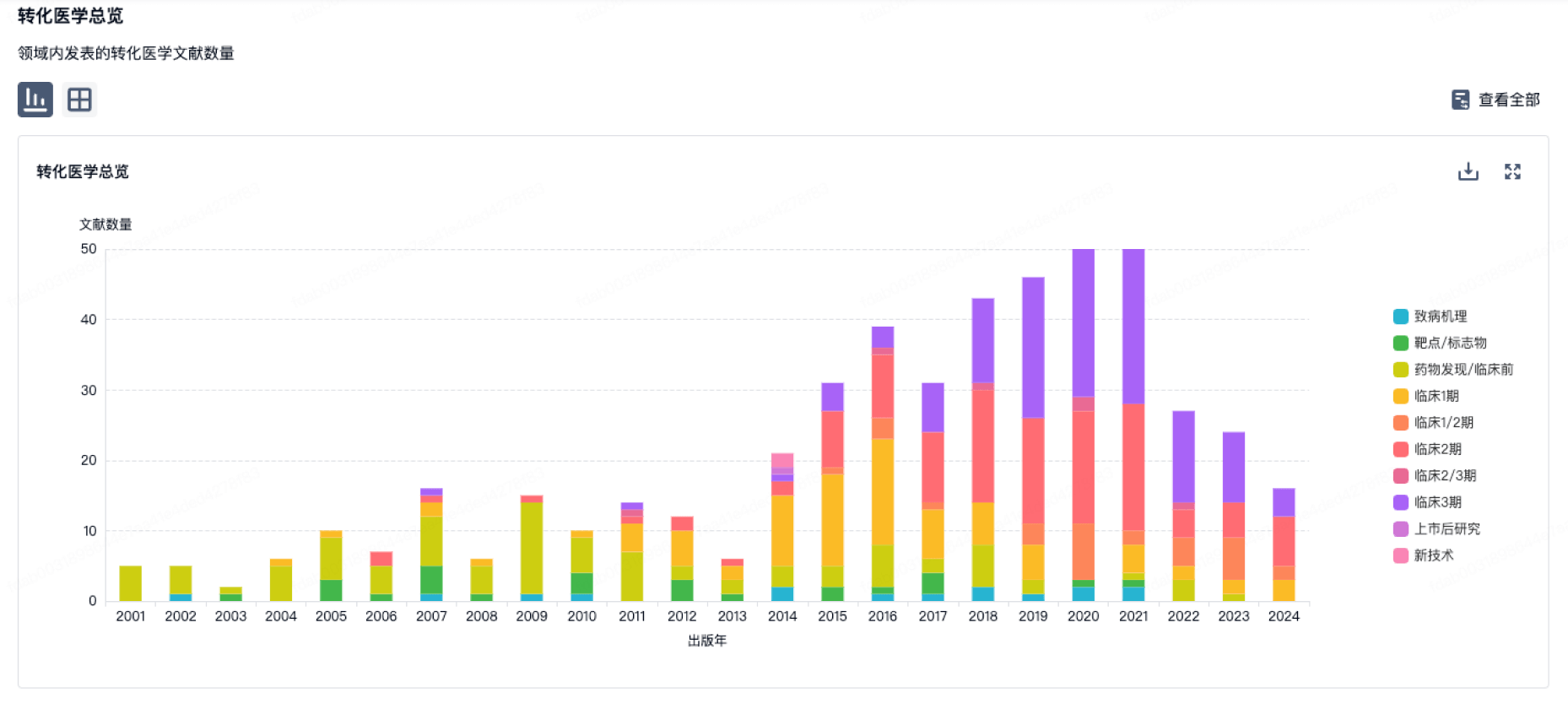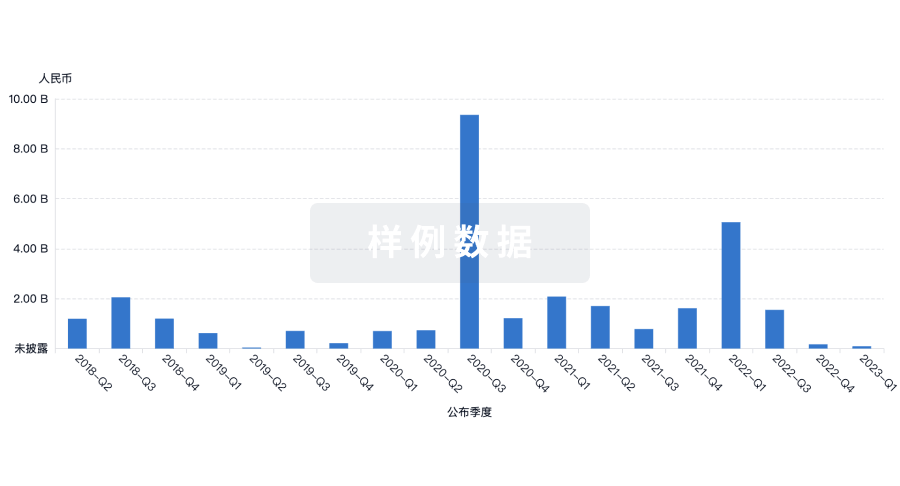预约演示
更新于:2025-11-26

Thermo Fisher Scientific, Inc.
更新于:2025-11-26
概览
标签
肿瘤
泌尿生殖系统疾病
心血管疾病
双特异性T细胞结合器
小分子化药
诊断用放射药物
疾病领域得分
一眼洞穿机构专注的疾病领域
暂无数据
技术平台
公司药物应用最多的技术
暂无数据
靶点
公司最常开发的靶点
暂无数据
| 排名前五的药物类型 | 数量 |
|---|---|
| 小分子化药 | 11 |
| 单克隆抗体 | 2 |
| ASO | 1 |
| 合成多肽 | 1 |
| 双特异性T细胞结合器 | 1 |
关联
19
项与 Thermo Fisher Scientific, Inc. 相关的药物作用机制 M1 receptor激动剂 [+1] |
非在研适应症- |
最高研发阶段批准上市 |
首次获批国家/地区 美国 |
首次获批日期2024-09-26 |
作用机制 HIV-1 capsid抑制剂 |
在研适应症 |
非在研适应症- |
最高研发阶段批准上市 |
首次获批国家/地区 欧盟 [+3] |
首次获批日期2022-08-17 |
419
项与 Thermo Fisher Scientific, Inc. 相关的临床试验NCT07015996
Efficacy of Tezepelumab in Peanut Oral Immunotherapy: a Double-Blind, Randomized, Placebo-Controlled Trial
The proposed study is a proof-of-concept Phase 2, double-blind, randomized placebo-controlled clinical trial evaluating the safety and efficacy of tezepelumab and peanut Oral Immunotherapy (OIT) for the treatment of peanut allergy. Study participation is divided into 3 periods: (i) a monotherapy period comprised of injections of either Tezepelumab or placebo from week 0 to week 8, (ii) followed by a combination therapy period comprised of 56 weeks during which peanut OIT is built up and maintained, and (iii) a treatment withdrawal period comprised of 12 weeks. This study will enroll 62 peanut-allergic individuals from 12 to 55 years of age who experience dose-limiting symptoms to <=100 mg of peanut protein in a single dose (<= 144 mg cumulative dose) as assessed by DBPCFC.
The primary objective is to determine whether 56 weeks of tezepelumab plus peanut OIT as compared to 56 weeks of placebo plus peanut OIT induces sustained unresponsiveness to peanut 12 weeks after stopping combination therapy.
The primary objective is to determine whether 56 weeks of tezepelumab plus peanut OIT as compared to 56 weeks of placebo plus peanut OIT induces sustained unresponsiveness to peanut 12 weeks after stopping combination therapy.
开始日期2026-02-18 |
NCT06594068
PRIMULA Lac (Prospective Registry Investigating Maternal, Infant, and Lactation Outcomes in Anifrolumab Users): The AstraZeneca Lactation Study for Anifrolumab
Prospective Registry Investigating Maternal, Infant, and Lactation Outcomes in Anifrolumab Users (PRIMULA Lac) is a Post Marketing Requirements (PMR) study designed to fulfill the FDA post-marketing requirements. The study will collect data about the presence of anifrolumab in human breast milk and serum (maternal and infant) among lactating individuals who receive anifrolumab therapeutically.
开始日期2026-01-30 |
申办/合作机构  AstraZeneca PLC AstraZeneca PLC [+1] |
NCT07247266
A Phase 1b, Open-label, Single-arm Study to Evaluate the Safety, Tolerability, Efficacy and Pharmacokinetics of JTE-162 in Subjects With Cryopyrin-Associated Periodic Syndrome (CAPS)
This study will evaluate the efficacy, safety, tolerability and pharmacokinetics of JTE-162 administered once daily for 2 weeks in subjects with cryopyrin-associated periodic syndrome (CAPS)
开始日期2025-12-01 |
申办/合作机构 Akros Pharma, Inc. [+1] |
100 项与 Thermo Fisher Scientific, Inc. 相关的临床结果
登录后查看更多信息
0 项与 Thermo Fisher Scientific, Inc. 相关的专利(医药)
登录后查看更多信息
5,345
项与 Thermo Fisher Scientific, Inc. 相关的文献(医药)2025-12-31·Expert Review of Vaccines
Modeling the potential public health and economic impact and cost-effectiveness of vaccination strategies using an adapted COVID-19 vaccine in Mexico
Article
作者: Huerta, Jose Luis ; Mendoza, Carlos Fernando ; Chirila, Iustina ; Kyaw, Moe H. ; Abreu, Dania ; Yarnoff, Benjamin
BACKGROUND:
This study evaluated the impact of vaccination strategies using an adapted COVID-19 vaccine in Mexico.
RESEARCH DESIGN AND METHODS:
This study used a previously published combined Markov-decision tree model adapted for the Mexican context. The base case examined the population aged ≥ 65 years and the high-risk population (defined as those with one or more comorbidities associated with high risk of severe disease) aged 12-64 years. Scenario analyses examined lower age cutoffs for eligibility in the standard risk population (≥50 years, ≥18 years, and ≥12 years). Sensitivity analyses varying the parameters by ± 20% was conducted to assess uncertainty.
RESULTS:
Compared to no vaccination, the base case was estimated to prevent 1,509,194 cases, 132,166 hospitalizations 24,575 deaths, and 276,223 lost quality-adjusted life-years (QALYs), increasing direct costs by $602,446,820 and decreasing societal cost by $2,264,266,271. The ICER was dominant from the societal perspective and $2,181 from the payer perspective, which was cost-effective at a willingness-to-pay threshold of 1× GDP per capita ($11,812). The benefits were further increased in scenarios expanding vaccination to additional age groups.
CONCLUSIONS:
Vaccination strategies targeting a broader age range with an adapted vaccine would result in considerable health and economic benefits and be cost-effective in Mexico.
2025-12-31·Expert Review of Vaccines
Modeling the potential public health and economic impact of different COVID-19 vaccination strategies with an adapted vaccine in the Kingdom of Saudi Arabia
Article
作者: Moussa, Mostafa ; Dodd, Josie ; Haridy, Hammam ; Kyaw, Moe H. ; Spinardi, Julia ; Elshabrawi, Mohammed Attia ; Mendoza, Carlos Fernando ; Yang, Jingyan ; Yarnoff, Benjamin ; Al Akoury, Nadine
BACKGROUND:
The dynamic evolution of the virus causing COVID-19 necessitates the development of adapted vaccines to protect against emerging variants.
RESEARCH DESIGN AND METHODS:
A combined Markov-decision tree model estimated the outcomes of alternative vaccination strategies. The Saudi Arabian population was stratified into standard-risk and high-risk subpopulations, defined as either the population comprising individuals aged ≥ 65 years and individuals with at least one comorbidity. The model estimated the health and economic outcomes of vaccination based on age-specific inputs taken from published sources and national surveillance data.
RESULTS:
The vaccination strategy targeting the elderly and high-risk subpopulation (was estimated to prevent 156,694 cases 12,800 hospitalizations, and 2,919 deaths and result in cost savings of SAR 1,239 million in direct costs and SAR 4,145 million in indirect costs. These gains increased with the vaccination strategies additionally targeting other subpopulations. Compared to the base case (aged ≥65 and those at high-risk), expanding vaccination coverage to 75% of the standard-risk population prevented more cases (323%), hospitalizations (154%), and deaths (60%) and increased the direct (232%) and indirect (270%) cost savings.
CONCLUSIONS:
The adoption of broad vaccination strategies using a vaccine adapted to the dominant variant in circulation would yield substantial benefits in Saudi Arabia.
2025-12-31·Expert Review of Vaccines
Reply to letter to editor “Comparative effectiveness of omicron XBB.1.5-adapted COVID-19 vaccines: a systematic literature review and network meta-analysis”
Article
作者: Cichewicz, Allie ; Burnett, Heather ; Volkman, Hannah R. ; Di Fusco, Manuela ; Chu, Haitao ; Fahrbach, Kyle ; Cappelleri, Joseph C. ; Mendoza, Carlos Fernando ; Akin-Fajiye, Morodoluwa
2,732
项与 Thermo Fisher Scientific, Inc. 相关的新闻(医药)2025-11-25
Hyderabad
:
Thermo Fisher Scientific
, in association with the government of Telangana and Department of Biotechnology has inaugurated a
Bioprocess Design Center
(BDC) in
Hyderabad
’s
Genome Valley
.
The centers will support 200 to 250 researchers and scientists by providing access to advanced technologies, hands-on training, and collaborative programs that accelerate innovation across
bioprocessing
, analytical sciences, healthcare, clean energy, and semiconductors.
The Center has bench-to-pilot scale capabilities for biologics and vaccines and is equipped with laboratories for cell culture, microbial fermentation, purification, and analytical testing.
Along with the BDC the company also launched a Customer Experience Center to demonstrate over 50 integrated workflows across 20 applications in targeted therapeutics like cell and gene therapy, mRNA, oncology, proteomics and analytical sciences featuring Thermo Fisher’s flagship technologies.
“Expanding our capability footprint through these centers demonstrate our vision to be the preferred partner for innovation, development, and manufacturing within the country,” said Srinath Venkatesh, MD, India and South Asia,
Thermo Fisher Scientific
.
By
Online Bureau
,

2025-11-24
·搜狐新闻
何为类器官? 为何被誉为“颠覆性技术”? 一文带你了解类器官技术!其正引领一场精准医疗的深层革命长安先导生命科学产业创新中心作为聚焦生命科学领域的产业创新领航者,正全力搭建集科研平台、技术转化、产业协作于一体的创新生态,而类器官技术作为前沿生物技术的核心方向之一,正是其重点布局的领域。依托自身一流的科研设施、产学研协同网络及对精准医疗的深度探索,长安先导持续推动类器官技术在药物研发、个性化诊疗等场景的落地应用,为这一“颠覆性技术”的产业化赋能。以下将带您全面了解类器官技术的核心价值、市场格局与发展趋势。在实验室的方寸之间,科学家们利用几个干细胞就能培育出一个仅有芝麻大小的“迷你肝脏”。别看它个头小,却 “五脏俱全”,功能相当完备,能像真实肝脏一样代谢药物,甚至还会像人体肝脏一样被病毒侵害。这可不是科幻电影里的情节,而是正在蓬勃发展的科学革命——类器官技术!近年来,类器官技术凭借其能高度模拟体内组织器官关键结构与功能特性的显著优势,在新药研发、疾病建模和个性化医疗等诸多领域大显身手,发挥着越来越重要的作用。QYResearch(恒州博智)调研显示,2024年全球类器官市场规模大约为0.67亿美元,预计2031年将达到2.15亿美元,2025-2031年期间的年复合增长率为18.4%。01 何为类器官?为何被誉为“颠覆性技术”? 类器官(Organoids)是从原代组织或干细胞在体外培育获得的3D细胞聚集体。它宛如一个神奇的微观世界,具备自我更新、自我组织的能力,并且能够展现出器官的功能。这种在体外精心培育而成的三维微器官,与体内真实器官拥有高度相似的遗传学背景及组织学特征,仿佛是真实器官的“微缩复刻版”。类器官技术之所以被视作“颠覆性技术”,关键在于它成功攻克了传统研究模型的诸多局限性。与传统的2D细胞系相比,2D细胞系生长在平面环境中,无法模拟体内器官复杂的三维结构和细胞间相互作用,而类器官的三维结构能更好地还原器官的真实环境,细胞间的交流与协作也更贴近体内情况。和动物模型相比,动物模型虽能在一定程度上模拟人类生理病理,但由于物种差异,其结果不能完全准确地外推至人类,而类器官来源于人体细胞,能更精准地模拟人体生理和病理状态,为生物医学研究搭建了一个更可靠、更贴近人体实际的优质平台。在个性化医疗领域,类器官技术更是展现出独特魅力。源自患者自身细胞的类器官,堪称一个专属的“试药浴缸”(Drug Screening)。以癌症治疗为例,医生可以利用患者的肿瘤组织培育出肿瘤类器官,然后用不同的抗癌药物对其进行测试,观察类器官的反应,从而筛选出最适合该患者的个性化治疗方案,真正实现“量体裁衣”式的精准治疗。此外,类器官技术在再生医学领域也蕴含着巨大潜力,或许在不久的将来,能为器官移植提供潜在的替代来源,缓解器官短缺的困境,同时,这一技术也高度符合动物实验3R原则(减少、优化、替代),有助于推动科研向更人道、更高效的方向发展。02 市场现状与发展方向 百花齐放 资本涌入的黄金赛道 2.1 市场规模与增长预测当下,类器官市场正处于迅猛发展的快车道。类器官市场规模预计将从2023年的30.3亿美元增至2031年的150.1亿美元,预计2023-2031年市场复合年增长率将达到22.3%,2031年市场规模达150亿美元。据QYResearch调研团队最新报告“中国类器官市场报告2023-2029”显示,预计2029年中国类器官市场规模将达到0.2亿美元,未来几年年复合增长率CAGR为31.3%。这一强劲的增长态势背后有着诸多驱动因素:癌症发病率的持续上升,使得对创新癌症治疗方法和精准诊断技术的需求极为迫切,类器官技术在癌症研究和治疗中的广泛应用,为市场增长注入了强大动力; 药物研发的高失败率与高昂成本,促使药企积极寻求更有效的研发模型,类器官能提供更接近人体的测试环境,大大提高了药物研发的成功率,降低了成本,因此备受药企青睐; 随着人们对健康关注度的提升,个性化医疗需求日益旺盛,类器官技术恰好能满足这一需求,为患者提供个性化的治疗方案,进一步推动了市场的扩张。 同时,技术的持续成熟,让类器官的培养、应用更加稳定和高效,也为市场增长奠定了坚实基础。政策端同样给力,对创新医疗技术给予了实质性支持,例如,FDA允许类器官数据作为新药审批的补充证据,这一举措直接缩短了企业的研发周期,极大地激发了企业投入类器官技术研发和应用的积极性。2.2 市场细分格局类器官市场犹如一个多元化的生态系统,可按应用领域和产品类型进行细致细分:从应用领域来看,生物医药领域独占鳌头,占据最大份额。在药物筛选环节,类器官能够模拟人体对药物的反应,帮助药企快速筛选出有潜力的药物分子,提高研发效率;在毒性测试方面,其能更准确地预测药物对人体的毒性,保障药物安全性;而在疾病建模中,类器官可构建出各种疾病的模型,助力科研人员深入研究疾病的发病机制,为开发新的治疗方法提供关键线索。临床诊疗领域也是类器官技术的重要应用方向,其中个性化医疗根据患者个体类器官的特性制定专属治疗方案,提高治疗效果;伴随诊断则借助类器官技术,更精准地判断患者的病情和预后,为临床决策提供有力支持。基础科研领域同样离不开类器官技术,在发育生物学研究中,类器官有助于科学家探索器官发育的奥秘;在宿主-病原体相互作用研究中,类器官可模拟病原体感染人体的过程,为传染病防治提供重要依据。按产品类型划分,类器官培养产品(试剂、培养基、基质胶等)构成了市场的重要基石。像Corning、Thermo Fisher、STEMCELL Technologies等企业,在这一领域深耕细作,为类器官培养提供了高质量的产品。类器官模型服务也是市场的关键板块,一些公司专注于提供特定疾病类型的类器官模型,或者为科研机构、药企提供专业的类器官培养服务。此外,仪器与设备板块也不可或缺,自动化培养设备让类器官培养过程更高效、稳定;成像系统能清晰观察类器官的结构和功能变化;分析系统则帮助科研人员深入解析类器官相关数据,为研究和应用提供有力支撑。2.3 竞争格局与主要玩家在类器官领域的全球竞争格局中,国际领先公司凭借先发优势占据了重要地位。Hubrecht Organoid Technology(HUB)在类器官技术研发和应用方面经验丰富,成果卓著;Crown Bioscience专注于为药企提供类器官相关的药物研发服务,在行业内拥有良好口碑;STEMCELL Technologies以其优质的类器官培养产品和技术服务,在市场上站稳脚跟;DefiniGEN、Prellis Biologics 和 Epistem 等企业也各有专长,在类器官的不同细分领域积极布局。中国本土企业近年来也如雨后春笋般快速崛起。丹望医疗聚焦于类器官技术在临床诊断和治疗中的应用,不断探索创新;创芯国际致力于类器官芯片的研发,将类器官技术与芯片技术相结合,为药物研发和疾病诊断带来新的解决方案;科途医学则在类器官模型构建和应用方面发力,为科研和临床提供专业服务。这些本土企业依托本土化优势,深入了解国内市场需求,在特色方向上持续创新,逐渐在市场上崭露头角,占据一席之地。药企与类器官公司的合作正日益深化和扩大。以辉瑞公司为例,其近年来积极推动类器官技术在药物研发流程中的应用,尤其在肿瘤领域开展了多项合作与研究。据报道,辉瑞已在部分肿瘤药物研发项目中采用类器官模型进行药效评估和毒性测试,通过高度模拟人体生理环境的类器官平台,显著提升了临床前研究的预测准确性,从而优化了研发效率并降低了后期失败风险。这种产学研紧密协作的模式,不仅为制药企业提供了创新的研发工具和思路,也为类器官技术公司带来丰富的应用场景和商业机会,进一步推动了类器官技术的标准化和产业化进程,形成良性循环的创新生态。2.4 未来发展方向与趋势展望未来,类器官技术的发展呈现出多个清晰的趋势。自动化与标准化是首要方向。当前,类器官培养在很大程度上依赖手工操作,这不仅耗费人力,而且容易导致批次间差异较大。实现自动化培养后,培养过程将更加精准、高效,减少人为因素干扰,提高类器官的质量稳定性。同时,建立统一的标准化流程,从细胞来源、培养条件到质量检测等各个环节都有明确标准,将有助于不同实验室、企业间数据的可比性和可重复性,推动类器官技术在全球范围内的广泛应用。血管化与免疫化也是关键趋势。目前的类器官普遍缺乏血管和免疫细胞,这限制了其进一步发展和应用。拥有血管系统后,类器官能更好地获取营养物质、排出代谢废物,维持长期稳定的功能;引入免疫细胞,则可模拟人体真实的免疫反应,在感染性疾病研究、免疫治疗研发等方面发挥更大作用。多器官微系统(Organ-on-a-Chip)技术正在蓬勃发展。该技术将不同类器官巧妙连接起来,模拟人体系统中器官间的相互作用。比如,构建肝-肾多器官微系统,可用于研究药物在肝脏代谢后对肾脏的影响,为更复杂的药理和毒理研究提供有力工具。监管认可路径也在稳步推进。随着类器官技术的不断发展,监管机构逐渐认识到其重要性和应用潜力,正在逐步完善相关法规和指南,使类器官数据能更顺利地成为药物申报和临床决策的有效证据,加速类器官技术从实验室走向临床应用的进程。03 政策与监管现状 从实验室走向临床的“导航图” 3.1 国际政策动态在国际舞台上,监管机构对类器官技术的接纳度正逐步提升。美国的FDA Modernization Act 2.0是一项具有里程碑意义的法案,它允许在药物毒理测试中使用非动物模型,其中就包括类器官,这一举措为类器官技术在药物研发领域的应用打开了新的大门,鼓励药企积极采用类器官技术,降低药物研发对动物实验的依赖,同时提高研发效率和准确性。类器官技术与人工智能的融合被视为未来的重要方向,有望为病理诊断带来革命性变化。目前,多家科技公司与研究机构正致力于开发此类工具,目标是通过AI算法提升类器官分析的准确性与效率,从而为临床医生提供更强大的决策支持。业界正积极与监管机构(比如FDA)沟通,推动相关技术的标准化与验证,此类‘AI+类器官’诊断方案的成功落地,将成为该领域迈向临床应用的关键一步。”欧洲药品管理局(EMA)对新兴技术秉持鼓励与审慎并重的态度。欧盟主导的“Organoid Standardization Initiative”正在全力推动类器官技术的标准化进程。通过制定统一的标准和规范,涵盖类器官的培养、鉴定、质量控制等各个方面,确保类器官在临床研究中的合规应用,提高研究结果的可靠性和可比性。这将有助于欧洲在类器官技术领域保持领先地位,促进类器官技术在欧洲乃至全球的广泛应用和发展。3.2 中国政策环境在中国,类器官技术受到了国家战略层面的大力支持。根据“十四五”国家重点研发计划,类器官技术被列为前沿生物技术的重要组成部分,获得了资金和政策上的有力扶持。2025年,中国启动了“前沿生物技术”重点专项,其中明确包含“复合类器官系统”和“类器官及复合类器官系统的数字化评估”等关键方向,并安排国拨经费概算总计1亿元。这充分彰显了国家对类器官技术发展的高度重视,为科研机构和企业开展类器官技术研究提供了坚实的资金保障。在地方层面,各地也纷纷出台相关政策助力类器官技术发展。广州市计划设立目标规模200亿元的生物医药专项基金,用于推动南沙开展细胞治疗临床应用管理试点,并探索“医保 + 商保”一站式结算模式。这一系列举措将为类器官技术在临床应用方面提供资金支持和政策便利,加速类器官技术的临床转化,让更多患者受益。3.3 面临的挑战尽管政策环境总体积极,类器官技术仍面临一些挑战,缺乏统一的质量标准是一个重要问题:如何定义一个“合格”的类器官?伦理问题也需要考虑,特别是脑类器官等敏感领域的伦理边界探讨。临床验证与审批路径仍是挑战:仍需大量临床数据来证明其指导临床决策的有效性;此外类器官开发和维护的复杂性和高成本也限制了其广泛应用。小结 类器官技术尽管前景广阔,但仍面临多方面挑战。在技术层面上,成熟度、血管化、标准化等问题仍需解决;在商业层面上,成本高和规模化生产难限制了其广泛应用;而在监管层面上,认可路径漫长,需要更多临床验证数据。展望未来,类器官技术的发展可能分为几个阶段:短期(1-3年),类器官可能作为药物研发的辅助工具被更广泛地采用;中期(3-5年),类器官有望在伴随诊断和个性化用药指导方面实现临床落地;长期(5-10年),类器官或许在再生医学领域带来惊喜,并与器官芯片、AI结合,构建“数字孪生人体”。类器官技术不仅是一种技术工具,更是理解生命、战胜疾病的新范式,如今,其正在改变药物研发的流程,提高精准医疗的水平,并为研究人类发育和疾病提供前所未有的窗口。随着技术的不断成熟、政策的持续支持和市场的快速增长,类器官技术有望在不久的将来带来更多突破性的医学进展,为人类健康事业做出重要贡献!返回搜狐,查看更多
2025-11-24
CAMBRIDGE, Mass.--(BUSINESS WIRE)--MindImmune Therapeutics, a private company developing new treatments targeting the inflammatory drivers of neurodegenerative disease, today announced two major milestones: the closing of a $10.2 million Series A extension, which brings the total Series A capital raised to $30 million and the appointment of Isaac Stoner as Chief Executive Officer. In addition, the company announced that Reetika Bhardwaj of Dolby Family Ventures and Isaac Stoner will join its Board of Directors. MindImmune’s founding CEO Stevin Zorn, PhD, will transition to the role of Chief Scientific Officer.
“Dr. Zorn and his co-founders have made a fundamental discovery that will change how we think about neurodegenerative diseases. MindImmune’s therapeutic programs have the potential to dramatically benefit Alzheimer’s patients by targeting the underlying inflammatory processes that damage synapses and blood vessels in the brain,” said Mr. Stoner. “I feel fortunate to be leading this talented company as we advance an important first-in-class therapeutic into clinical development.”
Mr. Stoner brings more than 18 years of experience in life sciences entrepreneurship and company building to MindImmune. He most recently served as entrepreneur-in-residence at Slater Technology Fund and as an advisor and limited partner at KdT Ventures. From 2017 to 2025, he co-founded and led Octagon Therapeutics, serving as CEO for five years. Earlier in his career, he held roles at Firefly BioWorks, Ion Torrent Systems, PureTech Health, the Martin Trust Center for MIT Entrepreneurship, Action Potential Venture Capital, and Genome Corp., and co-founded the non-profit Operation Thonapa. He holds a degree in biomedical engineering from Brown University and an MBA from the MIT Sloan School of Management.
The financing was led by Dolby Family Ventures, with participation from Pfizer Ventures, Gates Frontier, Slater Technology Fund, RightHill Ventures, the Foundation for a Better World, and others. Proceeds from the financing will be used to advance the company’s lead candidate, MITI-101, into Phase 1 clinical studies. MITI-101 is a monoclonal antibody designed to prevent peripheral immune cells from entering the brain and driving neuroinflammation linked to Alzheimer's disease progression.
“We’ve been deeply impressed by the progress MindImmune has made since our initial investment, and we believe that Isaac is well positioned to lead MindImmune as the company grows,” said Reetika Bhardwaj, Principal at Dolby Family Ventures. “The company’s novel approach to modulating neuroinflammation has the potential to change the treatment paradigm for Alzheimer’s and other neurodegenerative diseases.”
About MindImmune Therapeutics
MindImmune Therapeutics is a venture-backed biotechnology company developing products that target the immunological drivers of neurodegenerative disease. Its lead program, MITI-101, is designed to block the harmful recruitment of peripheral immune cells into the brain in patients with Alzheimer’s disease and other neurodegenerative conditions. By targeting a key upstream mechanism of neuroinflammation, MITI-101 has the potential to deliver a first-in-class therapeutic breakthrough that improves multiple aspects of neurodegeneration. For more information, please visit: www.mindimmune.com.
高管变更临床1期
100 项与 Thermo Fisher Scientific, Inc. 相关的药物交易
登录后查看更多信息
100 项与 Thermo Fisher Scientific, Inc. 相关的转化医学
登录后查看更多信息
组织架构
使用我们的机构树数据加速您的研究。
登录
或

管线布局
2025年12月17日管线快照
管线布局中药物为当前组织机构及其子机构作为药物机构进行统计,早期临床1期并入临床1期,临床1/2期并入临床2期,临床2/3期并入临床3期
临床前
2
1
临床申请
临床1期
2
1
临床2期
临床3期
4
7
申请上市
批准上市
2
20
其他
登录后查看更多信息
当前项目
| 药物(靶点) | 适应症 | 全球最高研发状态 |
|---|---|---|
阿达木单抗生物类似药 (Alvotech) ( TNF-α ) | 类风湿关节炎 更多 | 批准上市 |
门冬酰胺酶 ( ASN ) | 急性淋巴细胞白血病 更多 | 批准上市 |
奎扎替尼 ( FLT3 ) | 伴有 FLT3/ITD 突变的急性髓系白血病 更多 | 申请上市 |
甲苯磺酸尼拉帕利/醋酸阿比特龙 ( CYP17A1 x PARP1 x PARP2 ) | 激素依赖性前列腺癌 更多 | 申请上市 |
盐酸六氨基-γ-酮戊酸 | 膀胱癌 更多 | 申请上市 |
登录后查看更多信息
药物交易
使用我们的药物交易数据加速您的研究。
登录
或

转化医学
使用我们的转化医学数据加速您的研究。
登录
或

营收
使用 Synapse 探索超过 36 万个组织的财务状况。
登录
或

科研基金(NIH)
访问超过 200 万项资助和基金信息,以提升您的研究之旅。
登录
或

投资
深入了解从初创企业到成熟企业的最新公司投资动态。
登录
或

融资
发掘融资趋势以验证和推进您的投资机会。
登录
或

生物医药百科问答
全新生物医药AI Agent 覆盖科研全链路,让突破性发现快人一步
立即开始免费试用!
智慧芽新药情报库是智慧芽专为生命科学人士构建的基于AI的创新药情报平台,助您全方位提升您的研发与决策效率。
立即开始数据试用!
智慧芽新药库数据也通过智慧芽数据服务平台,以API或者数据包形式对外开放,助您更加充分利用智慧芽新药情报信息。
生物序列数据库
生物药研发创新
免费使用
化学结构数据库
小分子化药研发创新
免费使用


